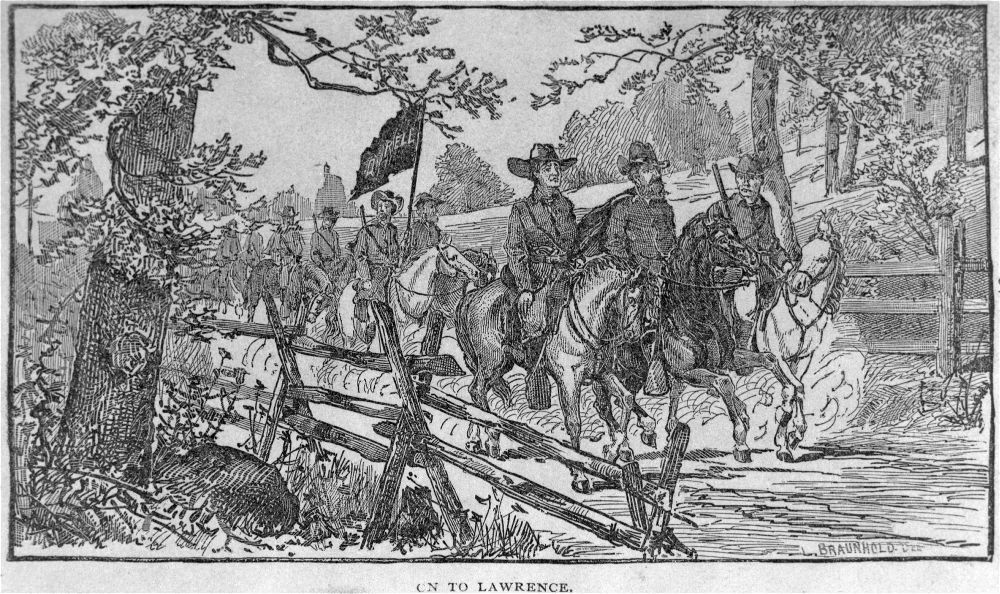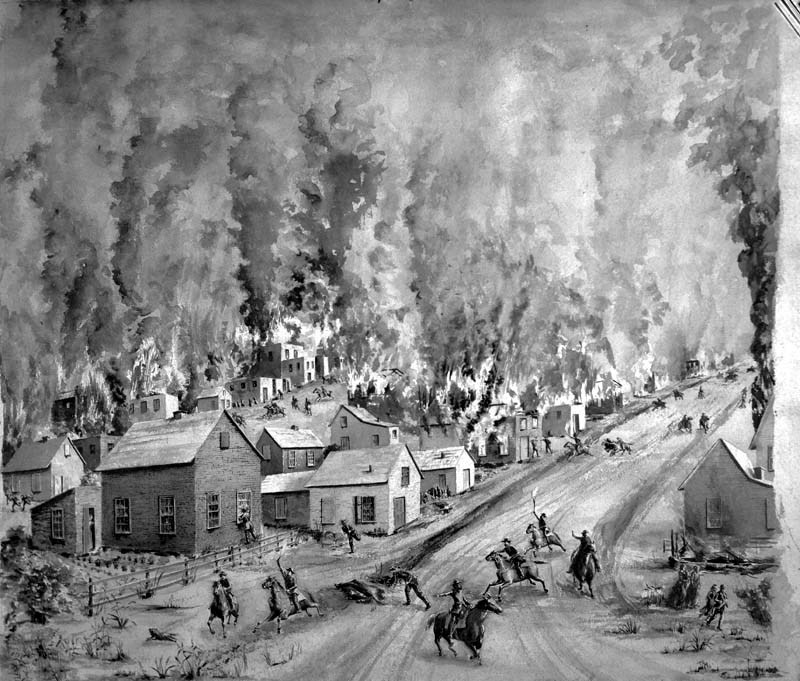The raid in art
If raiders rode into town and sacked Lawrence today, dozens of bystanders would capture the event on smartphones and photojournalists would quickly swarm the scene.
Of course, that wasn’t the case in 1863. Visual impressions of Quantrill’s raid are limited to original art — mostly drawings, paintings and prints — that was created later.
How much later, in some cases, has a distinct effect on how the events are portrayed.
There’s not a large amount of artwork depicting Quantrill’s raid, according to Kate Meyer, assistant curator of works on paper at the Spencer Museum of Art. However, she said, as the dramatic subject seems to increase in popularity, so does historical research on it and works of art inspired by it.
Lawrence massacre-inspired artwork ranges from thoroughly researched historical representations to juxtaposition of characters from the day into modern scenes. In nearly all interpretations, mayhem, blood and fire reign supreme.
Here’s an art-appreciation tour through some of the various depictions of the raid:

Image courtesy of the Spencer Museum of Art. “The Ballad of Quantrill’s Raiders,” 1992, acrylic on Masonite, by Joe Coleman.
“The Ballad of Quantrill’s Raiders”
Artist: Joe Coleman
Year: 1992
Medium: Acrylic on Masonite
Location: Spencer Museum of Art, 1301 Mississippi St. The painting will be temporarily on display the week of the anniversary of Quantrill’s raid. Curators plan to incorporate it into a future permanent exhibit being designed as part of Project Redefine, the museum’s ongoing overhaul of permanent galleries.
About: Stephen Goddard, associate director and senior curator of works on paper at the Spencer Museum of Art, first spotted this painting while he was looking for rock posters at a New York City shop called Psychedelic Solution. The Spencer borrowed the work for a 2004-2005 exhibition and purchased it last year.
Infamous historical events — especially violent ones — are a favorite theme of artist Joe Coleman, whose Brooklyn, N.Y., home features his collection of sideshow, serial killer and religious artifacts. An admirer of Northern Renaissance artists, Coleman produces paintings with the same exquisite detail — in “Ballad,” one can see individual hairs on Quantrill’s head.
Coleman’s interpretation — which portrays not just the raid but events and people surrounding it — is painstakingly researched, yet visceral and unflinching, Meyer said. Scenes include William T. “Bloody Bill” Anderson scalping a Union soldier at the Centralia, Mo., holdup and Quantrill on his deathbed, seeping blood from gunshots to his back and trigger finger. Dividing the four scenes is an X-shaped black banner, lined and bookended with portraits of Quantrill — the central figure — and his cohorts.

Image courtesy of the Spencer Museum of Art and the Ethel Magafan Estate. Lawrence Massacre, Mural Design for Fort Scott Kansas, 1937, watercolor on paper, by Ethel Magafan (1916-1993). This study for a mural that was never realized is in the Spencer Museum of Art's collection.
“Lawrence Massacre, Mural Design for Fort Scott Kansas”
Artist: Ethel Magafan
Year: 1937
Medium: Watercolor on paper
Location: Spencer Museum of Art. Not on display.
About: This small watercolor is an example of how controversial subject matter doesn’t always succeed in public art. Ethel Magafan, an artist working for the federal government’s Public Works of Art Project, created the sketch to win a commission for a mural in the Fort Scott post office. Her entry featuring simplified, geometric figures was a finalist but ultimately rejected, Meyer said, because it depicted a political and violent event — hardly a victory for Kansans — that the locals didn’t want on the wall of their post office.
Magafan created a few other studies for this mural that never was, including a second watercolor in the Spencer’s collection and a more detailed design owned by the Denver Art Museum.

Image copyright Ernst Ulmer, courtesy of Watkins Community Museum of History. Blood
“Blood Stained Dawn”
Artist: Ernst Ulmer
Year: 1991
Medium: Oil on canvas
Location: Watkins Community Museum of History, 1047 Massachusetts St. The painting is a key part of the museum’s new permanent exhibit, located on the second floor. (Framewoods Gallery, 819 Massachusetts St., also sells prints of it.)
About: Artist Ernst Ulmer of Bonner Springs was known for his meticulous historical research and commitment to authenticity. “Blood Stained Dawn” is a lifelike depiction of gunmen on horseback marching through downtown Lawrence, buildings engulfed in smoke in their wake.
Early last year, this large painting was for sale in a Kansas City, Mo., art gallery with a price tag of $30,000. A private trust (which wants to stay anonymous) has since purchased the painting and loaned it to the Watkins museum to be displayed there long-term, museum executive director Steve Nowak said.
“Their motivation was to have this painting in a public venue, preferably in Lawrence where it relates so much to our history,” Nowak said. “In some ways, I think it’s much more like what people would have witnessed at the time than the period illustrations that were published in East Coast magazines.”

Alvin Howell painting of Quantrill's Raid, commissioned in 1966 for old Lawrence City Hall, title unknown. The image is reproduced courtesy of the Douglas County Historical Society, Watkins Community Museum of History, where the painting is currently in storage.
Painting commissioned for old Lawrence City Hall, title unknown
Artist: Alvin Howell
Year: Commissioned 1966
Medium: Oil on canvas
Location: Watkins Community Museum. Not on display.
Description: The city of Lawrence commissioned artist Alvin Howell to paint this artwork, which was hung in 1967 in the Watkins building (then Lawrence’s city hall) and featured on the cover of the 1967 phone book, according to a 1980 Journal-World article. When city offices moved to 910 Massachusetts St. in 1970 the painting was in the fourth-floor city commission meeting room, but when the current city hall opened in 1980, officials said the painting didn’t fit with the building’s design and donated it to the Watkins museum, the article said.
Howell painted a collage of scenes from the raid, including burning buildings, a raider shooting a man while women look on and a shadowy graveyard.
“It symbolizes the utter lawlessness of the time,” Howell told the Journal-World in 1980, lobbying for the painting to be permanently displayed somewhere, if not in city hall. “This town was left to its own devices, and it’s inspiring that Lawrence was able to rebuild itself on its own after all that destruction.”

Lawrence Coffell painting of Quantrill's raid, date unknown. The image is reproduced courtesy of the Douglas County Historical Society, Watkins Community Museum of History, where the painting is currently in storage.
Painting of Quantrill’s raid, title unknown
Artist: Lawrence Coffell (spelling based on signature)
Year: Unknown
Medium: Oil paint on canvas board
Location: Watkins Community Museum. Not on display.
About: This 2-by-4-foot painting features a raider on a raring horse in the foreground with burning buildings in the background. The museum’s records don’t indicate how or when the museum obtained the painting, although it was added to the museum’s catalog in 2004.

Image courtesy of KansasMemory.org, Kansas State Historical Society. The
“The Lawrence Massacre”
Artist: Unknown
Year: 1863
Medium: Unspecified
Location: Kansas State Historical Society, Topeka
About: “Harper’s Weekly” magazine published this black and white illustration of the raid on Sept. 5, 1863, according to the historical society’s description. The image shows a chaotic scene, with a tangle of dead and wounded Lawrencians lying on the ground with others running from the raiders, the action framed by burning buildings and clouds of smoke.

Image courtesy of KansasMemory.org, Kansas State Historical Society. On to Lawrence, by L. Braunhold, circa 1883. This illustration was copied from the book Life and Adventures of the James Boys, by Jay Donald.
“On to Lawrence”
Artist: L. Braunhold
Year: Circa 1883
Medium: Unspecified
Location: Kansas State Historical Society, Topeka
About: This black and white illustration is a pastoral image of Quantrill and his men riding through the countryside toward Lawrence. According to the historical society’s description, the illustration was copied from the book “Life and Adventures of the James Boys,” by Jay Donald.

Image courtesy of KansasMemory.org, Kansas State Historical Society. Red Mountain, featuring Quantrill's Raiders comic book cover, Avon Periodicals Inc., 1952.
“Red Mountain, featuring Quantrill’s Raiders” comic book cover
Artist: Avon Periodicals Inc.
Year: 1952
Medium: Unspecified
Location: Kansas State Historical Society, Topeka
About: A fictional interpretation of Quantrill and his men, this color comic book features Quantrill’s Raiders from the movie “Red Mountain,” according to the historical society’s description. The glossy yellow cover depicts gunmen on horseback firing at a man trying to defend his burning cabin and is emblazoned with the teaser, “Alan Ladd battles the West’s most desperate outlaw killers!”

Image courtesy of KansasMemory.org, Kansas State Historical Society. Quantrill's Raid on Lawrence, pencil on wood pulp paper, by Sherman Bronson Enderton, circa 1868-1880. Enderton was a private in Company E, 11th Kansas Volunteer Cavalry, during the Civil War.
“Quantrill’s Raid on Lawrence”
Artist: Sherman Bronson Enderton
Year: Between 1868 and 1880
Medium: Pencil on wood pulp paper
Location: Kansas State Historical Society, Topeka
About: Sherman Enderton, a private in Company E, 11th Kansas Volunteer Cavalry, during the Civil War, drew his interpretation of the raid in sweeping black strokes with an ominous sky. Gunmen on horseback gallop through what appears to be an amalgamation of farms, homes and, in the background, larger buildings.

Image courtesy of KansasMemory.org, Kansas State Historical Society. Quantrill's Raid, black and white watercolor on paper, by Lauretta Louise Fox Fisk, circa 1866-1919.
“Quantrill’s Raid”
Artist: Lauretta Louise Fox Fisk
Year: Between 1866 and 1919
Medium: Black and white watercolor on paper
Location: Kansas State Historical Society, Topeka
About: Lauretta Louise Fox Fisk was the wife of Washburn College sociology professor D.M. Fisk, according to the historical society. A dark, smoky sky and crackling flames are prominent in the painting, a scene portrayed as if one were viewing the raid from a distance instead of eye-level.

Image courtesy of Michael Krueger. Quantrill in Life, lithography and intaglio print by Michael Krueger, 2004.

Image courtesy of Michael Krueger. Quantrill in Death, lithography and intaglio print by Michael Krueger, 2004.
“Quantrill in Life” and “Quantrill in Death”
Artist: Michael Krueger
Year: 2004
Medium: Lithography and intaglio print
Location: Private collection
About: Krueger, an associate professor of art at Kansas University, created a number of Quantrill-inspired works with a “contemporary twist” for the Lawrence sesquicentennial. The modern reflections on stories from the raid include this pair of 5-by-6-inch prints, “Quantrill in Life” and “Quantrill in Death.” The first depicts a seated Quantrill with multiple arms, each holding a gun, and the second a folding table full of relics, including Quantrill’s skull. It was believed that after Quantrill was killed, his body was dug up and his bones went on display in a traveling side show, Krueger said.
Krueger’s other prints on the theme include “Quantrill’s Cake” (lithography and intaglio print, 2004), in which a blood-drenched man and woman smile at each other over a cup of tea and a slice of cake, and “Lost Boys” (color etching, 2005), in which two children — one holding a pistol — sit beneath smoky skies in a surreal depiction of Lawrence’s Centennial Park skateboard park. Krueger said one story he read, written by a woman who survived the raid, told of Quantrill and his men bursting into her home and killing her husband, then demanding tea and cake served on the street. “Lost Boys” is an interpretation of another story, about two boys who fled the raid with a pistol and hid in the area now home to the park.

